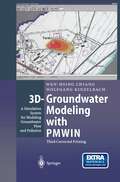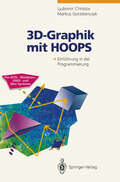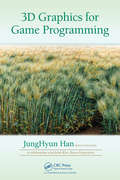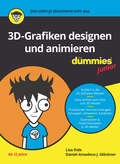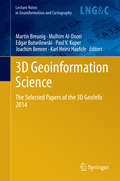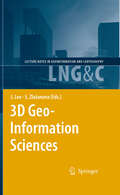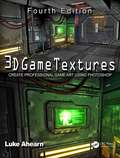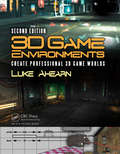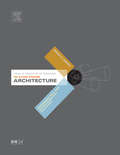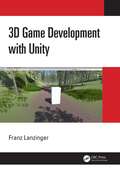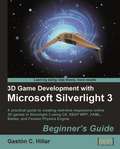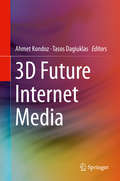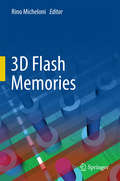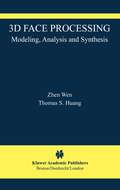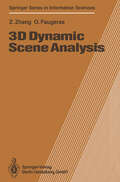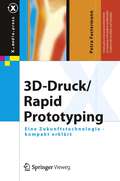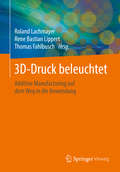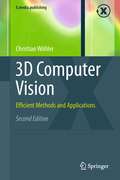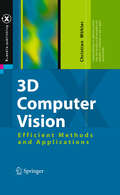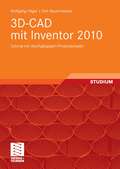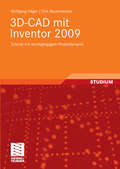- Table View
- List View
3D-Groundwater Modeling with PMWIN: A Simulation System for Modeling Groundwater Flow and Pollution
by Wen-Hsing Chiang Wolfgang KinzelbachThis book and CD-ROM offer a complete simulation system for modeling groundwater flow and transport processes. The companion full-version software (PMWIN) comes with a professional graphical user-interface, supported models and programs and several other useful modeling tools. Tools include a Presentation Tool, a Result Extractor, a Field Interpolator, a Field Generator, a Water Budget Calculator and a Graphic Viewer. Book and CD-ROM are targeted at novice and experienced groundwater modelers.
3D-Graphik mit HOOPS: Einführung in die Programmierung
by Ljubomir Christov Markus GorzelanczykDieses Buch ist sowohl eine systematische Einführung in das 3D-Grafiksystem HOOPS (Hierarchical Object-Oriented Picture System) als auch ein ausführliches Handbuch für dessen Programmierung. Es wird vorausgesetzt, daß der Benutzer die Grundbegriffe der Computergrafik beherrscht. Der Neuling, der Hoops kennen- und nutzen lernen möchte, kann das Buch als Lehrbuch verwenden. Jedes Kapitel behandelt einen abgeschlossenen Aspekt von Hoops. Dabei werden die jeweils relevanten Prozeduren zusammengefaßt und kurz erläutert. Anschauliche Beispiele erleichtern das Verständnis. Der schon mit Hoops vertraute Leser kann das Buch als Nachschlagewerk für die Programmierung benutzen. Eine ausführliche Prozedur-Referenz rundet das Buch ab. Mit zahlreichen Programmierbeispielen in C.
3D Graphics for Game Programming
by JungHyun HanDesigned for advanced undergraduate and beginning graduate courses, 3D Graphics for Game Programming presents must-know information for success in interactive graphics. Assuming a minimal prerequisite understanding of vectors and matrices, it also provides sufficient mathematical background for game developers to combine their previous experie
3D-Grafiken Designen und animieren für Dummies Junior (Für Dummies)
by Daniel-Amadeus J. Glockner Lisa IhdeIn diesem Buch lernst du Schritt für Schritt, wie du mit der kostenlosen Software Blender 3D-Objekte für Computerspiele, Videos oder für die Produktion im 3D-Drucker erstellst. Du erfährst, wie du aus einem 2D-Bild ein 3D-Modell machst, wie du das Material änderst, aus dem dein Objekt scheinbar hergestellt ist, wie du Oberflächen gestaltest und was es mit der Mesh-Modellierung auf sich hat. Außerdem kannst du deine Objekte animieren oder beispielsweise Explosionen simulieren. Bestens geeignet für Kinder und Jugendliche ab 12 Jahren.
3D Geoinformation Science: The Selected Papers of the 3D GeoInfo 2014 (Lecture Notes in Geoinformation and Cartography #94)
by Martin Breunig Mulhim Al-Doori Edgar Butwilowski Paul V. Kuper Joachim Benner Karl Heinz HaefeleNowadays 3D Geoinformation is needed for many planning and analysis tasks. For example, 3D city and infrastructure models are paving the way for complex environmental and noise analyzes. 3D geological sub-surface models are needed for reservoir exploration in the oil-, gas-, and geothermal industry. Thus 3D Geoinformation brings together researchers and practitioners from different fields such as the geo-sciences, civil engineering, 3D city modeling, 3D geological and geophysical modeling, and, last but not least, computer science. The diverse challenges of 3D Geoinformation Science concern new approaches and the development of standards for above- and under-ground 3D modeling, efficient 3D data management, visualization and analysis. Finally, the integration of different 3D approaches and data models is seen as one of the most important challenges to be solved.
3D Geo-Information Sciences (Lecture Notes in Geoinformation and Cartography)
by Jiyeong Lee Siyka ZlatanovaIn recent years 3D geo-information has become an important research area due to the increased complexity of tasks in many geo-scientific applications, such as sustainable urban planning and development, civil engineering, risk and disaster management and environmental monitoring. Moreover, a paradigm of cross-application merging and integrating of 3D data is observed. The problems and challenges facing today’s 3D software, generally application-oriented, focus almost exclusively on 3D data transportability issues – the ability to use data originally developed in one modelling/visualisation system in other and vice versa. Tools for elaborated 3D analysis, simulation and prediction are either missing or, when available, dedicated to specific tasks. In order to respond to this increased demand, a new type of system has to be developed. A fully developed 3D geo-information system should be able to manage 3D geometry and topology, to integrate 3D geometry and thematic information, to analyze both spatial and topological relationships, and to present the data in a suitable form. In addition to the simple geometry types like point line and polygon, a large variety of parametric representations, freeform curves and surfaces or sweep shapes have to be supported. Approaches for seamless conversion between 3D raster and 3D vector representations should be available, they should allow analysis of a representation most suitable for a specific application.
3D Game Textures: Create Professional Game Art Using Photoshop
by Luke AhearnThe new edition of 3D Game Textures: Create Professional Game Art Using Photoshop features the most up-to-date techniques that allow you to create your own unique textures, shaders, and materials. Revised to take new technology into account, it is an ideal hands-on resource for creating online worlds, simulations, web-based applications, and architectural visualization projects. Continuing the practical, no-nonsense approach of its predecessors, the fourth edition shows you how to advance your digital art skills with textures and shaders by exploring their interactions in single objects or entire scenes. It contains expanded coverage of shader nodes, and the companion website—www.lukeahearn.com/textures—has been updated to include video tutorials as well as updated sample textures, shaders, materials, actions, brushes, and all of the art from the book.
3D Game Textures: Create Professional Game Art Using Photoshop
by Luke AhearnThe new edition of 3D Game Textures: Create Professional Game Art Using Photoshop features the most up-to-date techniques that allow you to create your own unique textures, shaders, and materials. Revised to take new technology into account, it is an ideal hands-on resource for creating online worlds, simulations, web-based applications, and architectural visualization projects. Continuing the practical, no-nonsense approach of its predecessors, the fourth edition shows you how to advance your digital art skills with textures and shaders by exploring their interactions in single objects or entire scenes. It contains expanded coverage of shader nodes, and the companion website—www.lukeahearn.com/textures—has been updated to include video tutorials as well as updated sample textures, shaders, materials, actions, brushes, and all of the art from the book.
3D Game Environments: Create Professional 3D Game Worlds
by Luke AhearnFrom a steamy jungle to a modern city, or even a sci-fi space station, 3D Game Environments is the ultimate resource to help you create AAA quality art for a variety of game worlds. Primarily using Photoshop and 3ds Max, students will learn to create realistic textures from photo source and a variety of techniques to portray dynamic and believable game worlds. With detailed tutorials on creating 3D models, applying 2D art to 3D models, and clear concise advice on issues of efficiency and optimization for a 3D game engine, Luke Ahearn gives you everything students need to make their own realistic game environments.
3D Game Environments: Create Professional 3D Game Worlds
by Luke AhearnFrom a steamy jungle to a modern city, or even a sci-fi space station, 3D Game Environments is the ultimate resource to help you create AAA quality art for a variety of game worlds. Primarily using Photoshop and 3ds Max, students will learn to create realistic textures from photo source and a variety of techniques to portray dynamic and believable game worlds. With detailed tutorials on creating 3D models, applying 2D art to 3D models, and clear concise advice on issues of efficiency and optimization for a 3D game engine, Luke Ahearn gives you everything students need to make their own realistic game environments. Key Features The entire game world development process; from planning to 3D modeling, UV layout, and creating textures. Exercises and projects to practice with; each section includes projects to guide you through creating different world genres. The updated companion website—www.lukeahearn.com/textures/ now includes video tutorials in addition to updated sample textures, shaders, materials, actions, brushes, program demos, plug-ins and all art from the book—all the tools you need in one place.
3D Game Engine Architecture: Engineering Real-Time Applications with Wild Magic
by David EberlyDave Eberly's 3D Game Engine Design was the first professional guide to the essential concepts and algorithms of real-time 3D engines and quickly became a classic of game development. Dave's new book 3D Game Engine Architecture continues the tradition with a comprehensive look at the software engineering and programming of 3D engines. This book is
3D Game Development with Unity
by Franz LanzingerThis book teaches beginners and aspiring game developers how to develop 3D games with Unity. Thousands of commercial games have been built with Unity. This book combines a practical, step-by-step approach with explanations of the underlying theory that are reinforced with hundreds of screenshots and several larger projects. Building on the knowledge developed in 2D Game Development for Unity, this book uses the Blender software for 3D modelling and texturing, GIMP for 2D art, Audacity for sound effects, and MuseScore for music composition and notation. Readers can follow the step-by-step guides and create an introductory racing game, a 3D maze game, and a 3D FPS adventure game as they progress through the chapters. The book contains numerous color illustrations and online access to easily downloadable game assets, code, and project files. Written to be accessible and easy to follow, this book will be a valuable resource to both beginner and aspiring game developers that want to develop 3D games with Unity. Franz Lanzinger is an independent game developer, author, and pianist. He is the owner of Lanzinger Studio located in Sunnyvale, California. His game development career spans almost 40 years starting with the coin-op classic Crystal Castles at Atari in 1983, continuing with Ms. Pacman and Toobin' for the NES, published by Tengen in 1990. Franz has been an indie game developer since 1991. He worked on SNES Rampart, Championship Pool, and NCAA Final Four Basketball, as well as Gubble for the PC, Mac, and PlayStation. This is Franz's third book about game development. He is currently working on a remaster of Gubble. In his spare time, he is the piano accompanist for the Valley Chorale and the Serendipity Choir. Go to franzlanzinger.com for the latest news about Franz as well as resources for his books.
3D Game Development with Unity
by Franz LanzingerThis book teaches beginners and aspiring game developers how to develop 3D games with Unity. Thousands of commercial games have been built with Unity. This book combines a practical, step-by-step approach with explanations of the underlying theory that are reinforced with hundreds of screenshots and several larger projects. Building on the knowledge developed in 2D Game Development for Unity, this book uses the Blender software for 3D modelling and texturing, GIMP for 2D art, Audacity for sound effects, and MuseScore for music composition and notation. Readers can follow the step-by-step guides and create an introductory racing game, a 3D maze game, and a 3D FPS adventure game as they progress through the chapters. The book contains numerous color illustrations and online access to easily downloadable game assets, code, and project files. Written to be accessible and easy to follow, this book will be a valuable resource to both beginner and aspiring game developers that want to develop 3D games with Unity. Franz Lanzinger is an independent game developer, author, and pianist. He is the owner of Lanzinger Studio located in Sunnyvale, California. His game development career spans almost 40 years starting with the coin-op classic Crystal Castles at Atari in 1983, continuing with Ms. Pacman and Toobin' for the NES, published by Tengen in 1990. Franz has been an indie game developer since 1991. He worked on SNES Rampart, Championship Pool, and NCAA Final Four Basketball, as well as Gubble for the PC, Mac, and PlayStation. This is Franz's third book about game development. He is currently working on a remaster of Gubble. In his spare time, he is the piano accompanist for the Valley Chorale and the Serendipity Choir. Go to franzlanzinger.com for the latest news about Franz as well as resources for his books.
3D Game Development with Microsoft Silverlight 3: Beginner's Guide : A Practical Guide To Creating Real-time Responsive Online 3d Games In Silverlight 3 Using C#, Xbap Wpf, Xaml, Balder, And Farseer Physics Engine
by Gaston C. HillarThis book takes a step-by-step approach to building a complete interactive 3D game using Silverlight and enhancing it through its related technologies. The book focuses on practical examples and has a friendly approach, with the opportunity to learn by experiment and play. It uses illustrations, screenshots, and interactive experiences to understand the most complex topics related to the 3D scenes. This book is designed primarily for C# developers with basic knowledge of the Visual Studio IDE who want to develop online 3D games using Silverlight or create interactive 3D scenes for a web site with animated models. No prior experience in 3D programming, 3D animation, or Silverlight is required. The book is also aimed at 3D developers who want to improve their online content, offering innovative 3D models in action.
3D Future Internet Media
by Ahmet Kondoz Tasos DagiuklasThis book describes recent innovations in 3D media and technologies, with coverage of 3D media capturing, processing, encoding, and adaptation, networking aspects for 3D Media, and quality of user experience (QoE). The main contributions are based on the results of the FP7 European Projects ROMEO, which focus on new methods for the compression and delivery of 3D multi-view video and spatial audio, as well as the optimization of networking and compression jointly across the Future Internet (www.ict-romeo.eu). The delivery of 3D media to individual users remains a highly challenging problem due to the large amount of data involved, diverse network characteristics and user terminal requirements, as well as the user’s context such as their preferences and location. As the number of visual views increases, current systems will struggle to meet the demanding requirements in terms of delivery of constant video quality to both fixed and mobile users. ROMEO will design and develop hybrid-networking solutions that combine the DVB-T2 and DVB-NGH broadcast access network technologies together with a QoE aware Peer-to-Peer (P2P) distribution system that operates over wired and wireless links. Live streaming 3D media needs to be received by collaborating users at the same time or with imperceptible delay to enable them to watch together while exchanging comments as if they were all in the same location.The volume provides state-of-the-art information on 3D multi-view video, spatial audio networking protocols for 3D media, P2P 3D media streaming, and 3D Media delivery across heterogeneous wireless networks among other topics. Graduate students and professionals in electrical engineering and computer science with an interest in 3D Future Internet Media will find this volume to be essential reading.
3D Flash Memories
by Rino MicheloniThis book walks the reader through the next step in the evolution of NAND flash memory technology, namely the development of 3D flash memories, in which multiple layers of memory cells are grown within the same piece of silicon. It describes their working principles, device architectures, fabrication techniques and practical implementations, and highlights why 3D flash is a brand new technology.After reviewing market trends for both NAND and solid state drives (SSDs), the book digs into the details of the flash memory cell itself, covering both floating gate and emerging charge trap technologies. There is a plethora of different materials and vertical integration schemes out there. New memory cells, new materials, new architectures (3D Stacked, BiCS and P-BiCS, 3D FG, 3D VG, 3D advanced architectures); basically, each NAND manufacturer has its own solution. Chapter 3 to chapter 7 offer a broad overview of how 3D can materialize. The 3D wave is impacting emerging memories as well and chapter 8 covers 3D RRAM (resistive RAM) crosspoint arrays. Visualizing 3D structures can be a challenge for the human brain: this is way all these chapters contain a lot of bird’s-eye views and cross sections along the 3 axes.The second part of the book is devoted to other important aspects, such as advanced packaging technology (i.e. TSV in chapter 9) and error correction codes, which have been leveraged to improve flash reliability for decades. Chapter 10 describes the evolution from legacy BCH to the most recent LDPC codes, while chapter 11 deals with some of the most recent advancements in the ECC field. Last but not least, chapter 12 looks at 3D flash memories from a system perspective. Is 14nm the last step for planar cells? Can 100 layers be integrated within the same piece of silicon? Is 4 bit/cell possible with 3D? Will 3D be reliable enough for enterprise and datacenter applications? These are some of the questions that this book helps answering by providing insights into 3D flash memory design, process technology and applications.
3D Face Processing: Modeling, Analysis and Synthesis (The International Series in Video Computing #8)
by Zhen Wen Thomas S. Huang3D Face Processing: Modeling, Analysis and Synthesis introduces the frontiers of 3D face processing techniques. It reviews existing 3D face processing techniques, including techniques for 3D face geometry modeling; 3D face motion modeling; and 3D face motion tracking and animation. Then it discusses a unified framework for face modeling, analysis and synthesis. In this framework, the authors present new methods for modeling complex natural facial motion, as well as face appearance variations due to illumination and subtle motion. Then the authors apply the framework to face tracking, expression recognition and face avatar for HCI interface. They conclude this book with comments on future work in the 3D face processing framework. 3D Face Processing: Modeling, Analysis and Synthesis will interest those working in face processing for intelligent human computer interaction and video surveillance. It contains a comprehensive survey on existing face processing techniques, which can serve as a reference for students and researchers. It also covers in-depth discussion on face motion analysis and synthesis algorithms, which will benefit more advanced graduate students and researchers.
3D Dynamic Scene Analysis: A Stereo Based Approach (Springer Series in Information Sciences #27)
by Zhengyou Zhang Olivier Faugerashe problem of analyzing sequences of images to extract three-dimensional T motion and structure has been at the heart of the research in computer vi sion for many years. It is very important since its success or failure will determine whether or not vision can be used as a sensory process in reactive systems. The considerable research interest in this field has been motivated at least by the following two points: 1. The redundancy of information contained in time-varying images can over come several difficulties encountered in interpreting a single image. 2. There are a lot of important applications including automatic vehicle driv ing, traffic control, aerial surveillance, medical inspection and global model construction. However, there are many new problems which should be solved: how to effi ciently process the abundant information contained in time-varying images, how to model the change between images, how to model the uncertainty inherently associated with the imaging system and how to solve inverse problems which are generally ill-posed. There are of course many possibilities for attacking these problems and many more remain to be explored. We discuss a few of them in this book based on work carried out during the last five years in the Computer Vision and Robotics Group at INRIA (Institut National de Recherche en Informatique et en Automatique).
3D-Druck/Rapid Prototyping: Eine Zukunftstechnologie - kompakt erklärt (X.media.press)
by Petra FastermannImmer mehr Kreative nutzen die Möglichkeit, eigene dreidimensionale Objekte in Kunststoff, Metall oder Keramik schnell und preisgünstig herstellen zu lassen. Der 3D-Druck ist eine revolutionäre Technologie, die dieVerwirklichung von Ideen ermöglicht. 3D-Drucker werden immer kleiner und leistungsstärker und damit bürotauglicher. Eine umfassende Beschreibung dieser Zukunftstechnologie bietet dieses praxisnahe und anwenderorientierte Buch. Dabei hilft es mit Tipps und Hinweisen bei der Auswahl des optimalen CAD-Programms und 3D-Druckers.
3D-Druck beleuchtet: Additive Manufacturing auf dem Weg in die Anwendung
by Roland Lachmayer Rene Bastian Lippert Thomas FahlbuschDas vorliegende Buch zeigt einen Überblick über das breite Anwendungsfeld des Additive Manufacturing, mit dem Fokus auf den industriellen Einsatz unterschiedlicher Technologien. Nach der Beschreibung eines allgemeinen Grundverständnisses und der Einschätzung zur Nutzung von Additive Manufacturing Verfahren in der Produktentwicklung werden verschiedene Technologien hinsichtlich von Nachhaltigkeits-, Individualisierungs-, Qualifizierungs- und Gestaltungsaspekten analysiert. Dabei liegt der Fokus stets auf der Betrachtung der gesamten Prozesskette, vom Pre-Prozess über den In- und Post-Prozess bis hin zur Anwendung. Die abschließende Betrachtung von Sicherheitsmerkmalen des Additive Manufacturing resultiert in der Einschätzung zukünftiger Entwicklungen im Bereich des Additive Manufacturing.
3D Computer Vision: Efficient Methods and Applications (X.media.publishing)
by Christian WöhlerThis indispensable text introduces the foundations of three-dimensional computer vision and describes recent contributions to the field. Fully revised and updated, this much-anticipated new edition reviews a range of triangulation-based methods, including linear and bundle adjustment based approaches to scene reconstruction and camera calibration, stereo vision, point cloud segmentation, and pose estimation of rigid, articulated, and flexible objects. Also covered are intensity-based techniques that evaluate the pixel grey values in the image to infer three-dimensional scene structure, and point spread function based approaches that exploit the effect of the optical system. The text shows how methods which integrate these concepts are able to increase reconstruction accuracy and robustness, describing applications in industrial quality inspection and metrology, human-robot interaction, and remote sensing.
3D Computer Vision: Efficient Methods and Applications (X.media.publishing)
by Christian WöhlerThis work provides an introduction to the foundations of three-dimensional c- puter vision and describes recent contributions to the ?eld, which are of methodical and application-speci?c nature. Each chapter of this work provides an extensive overview of the corresponding state of the art, into which a detailed description of new methods or evaluation results in application-speci?c systems is embedded. Geometric approaches to three-dimensional scene reconstruction (cf. Chapter 1) are primarily based on the concept of bundle adjustment, which has been developed more than 100 years ago in the domain of photogrammetry. The three-dimensional scene structure and the intrinsic and extrinsic camera parameters are determined such that the Euclidean backprojection error in the image plane is minimised, u- ally relying on a nonlinear optimisation procedure. In the ?eld of computer vision, an alternative framework based on projective geometry has emerged during the last two decades, which allows to use linear algebra techniques for three-dimensional scene reconstructionand camera calibration purposes. With special emphasis on the problems of stereo image analysis and camera calibration, these fairly different - proaches are related to each other in the presented work, and their advantages and drawbacks are stated. In this context, various state-of-the-artcamera calibration and self-calibration methods as well as recent contributions towards automated camera calibration systems are described. An overview of classical and new feature-based, correlation-based, dense, and spatio-temporal methods for establishing point c- respondences between pairs of stereo images is given.
3D Character Rigging in Blender: Bring your characters to life through rigging and make them animation-ready
by Jaime KellyLeverage expert advice, step-by-step guidance, and comprehensive visual aids to pave your way towards excellence in the art of 3D character riggingKey FeaturesLearn how to use automatic and manual weight painting to merge skin and boneEnhance any rig with a sweeping host of automatic controls and aids for animationKeep your rigs efficient and clean for an optimal end user experiencePurchase of the print or Kindle book includes a free PDF eBookBook DescriptionIn the intricate world of 3D character rigging with Blender, aspiring artists often find themselves grappling with the daunting challenge of achieving results akin to seasoned professionals. This book is your guide to overcoming that very challenge, providing you with the necessary knowledge and skills to excel in this complex art form. As you embark on this creative journey, this book will guide you through a carefully crafted flow. Beginning with the basics, the first part of the book will teach you how to add structure to an empty canvas and master the art of weight painting in Blender. You'll delve into the intricacies of rigging humanoid characters, gain a deep understanding of the essential buttons and techniques, and discover invaluable success-boosting tips. Starting with simple mesh deformation using a single bone, you'll progress steadily toward the mastery of fully rigging a human character, all while comprehending the reasons behind each step in the process. Furthermore, the book leaves you with a selection of advanced techniques, fully explained, paving the way for a natural progression in your artistic journey and allowing you to continuously refine and enhance your skills. By the end of the book, you'll excel at crafting character rigs, seamlessly meeting professional pipeline demands in diverse teams and studios.What you will learnUnderstand the basic terminology of rigging and learn how to create and modify rigsFind out how bones interact with topologyGet to grips with weight painting through the meshKnow when and how to add constraints such as Inversion Kinetics, Point To, and Child OfMake rigs visually appealing with advanced techniques such as shape keys and bone driversFamiliarize yourself with advanced techniques used by industry leadersWho this book is forIf you are an animator, modeler, or someone who wants to start rigging with a solid foundation, then this book is for you. You’ll need no prior knowledge of Blender to get started with this book, as we’ll go step by step with shortcuts and UI pointers provided.
3D-CAD mit Inventor 2010: Tutorial mit durchgängigem Projektbeispiel
by Wolfgang Häger Dirk BauermeisterDieses Tutorial beschreibt sehr anschaulich und Schritt für Schritt die Erzeugung eines Gesamtprojekts Schraubstock. Dadurch lässt sich der Handlungsablauf zu jedem Zeitpunkt nachvollziehen. Neben der reinen 3D-Modellierung wird auch die Gestaltung von Präsentationen und Animationen dargestellt und somit ein ganzheitlicher Ansatz realisiert. Das Buch wendet sich an alle Einsteiger, die sicher das Arbeiten mit diesem 3D-CAD-System erlernen möchten.
3D-CAD mit Inventor 2009: Tutorial mit durchgängigem Projektbeispiel
by Wolfgang Häger Dirk BauermeisterDieses Tutorial beschreibt sehr anschaulich und Schritt für Schritt die Erzeugung eines Gesamtprojekts Schraubstock. Dadurch lässt sich der Handlungsablauf zu jedem Zeitpunkt nachvollziehen. Neben der reinen 3D-Modellierung wird auch die Gestaltung von Präsentationen und Animationen dargestellt und somit ein ganzheitlicher Ansatz realisiert. Das Buch wendet sich an alle Einsteiger, die sicher das Arbeiten mit diesem 3D-CAD-System erlernen möchten.
